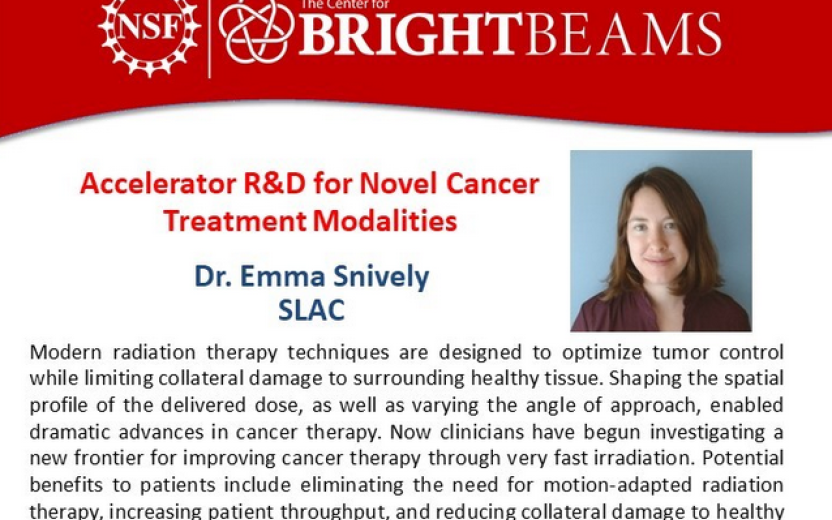Special Seminar with Dr. Emma Snively:
Spotlight metadata

Title: Accelerator R&D for Novel Cancer Treatment Modalities
Abstract:
Modern radiation therapy techniques are designed to optimize tumor control while limiting collateral damage to surrounding healthy tissue. Shaping the spatial profile of the delivered dose, as well as varying the angle of approach, enabled dramatic advances in cancer therapy. Now clinicians have begun investigating a new frontier for improving cancer therapy through very fast irradiation. Potential benefits to patients include eliminating the need for motion-adapted radiation therapy, increasing patient throughput, and reducing collateral damage to healthy tissue through the FLASH effect, but today’s commercial medical accelerators can’t reach the dose rates needed to capitalize on these advantages.
I will report on the status of medical accelerator R&D programs underway at SLAC to overcome the conventional limitations on dose rate through innovations in accelerator design. I will discuss the recent advances in high gradient accelerator research that we are using to push the state-of-the-art in terms of dose rate, RF efficiency, and compactness. These techniques are applicable to all accelerator-based radiation therapy systems, as well as accelerator R&D for discovery science. Research efforts at SLAC include designs for pencil beam scanning of proton beams, direct electron therapy using Very High Energy Electron (VHEE) beams, and conventional X-ray radiation therapy at high dose rates.
Bio:
Dr. Emma Snively is a Staff Scientist in the Technology Innovation Directorate at SLAC National Accelerator Laboratory. Dr. Snively’s research has focused on the development of next generation high-gradient accelerators and precision beam manipulation, with an emphasis on medical accelerator applications. Dr. Snively is the Operations Manager for the Next Linear Collider Test Accelerator (NLCTA) facility at SLAC and is currently leading projects funded by the U.S. Department of Energy Office of Accelerator R&D and Production (ARDAP) to develop compact systems for Very High Energy Electron (VHEE) therapy and RF-based high speed pencil beam scanning for hadron therapy. Dr. Snively’s research interests include high frequency accelerator design, pushing beyond the RF frequency range of conventional beam manipulation to enable more compact, high rep-rate, high efficiency structures, and to find new applications for THz science.
Dr. Emma Snively joined SLAC National Accelerator Laboratory after completing her doctoral degree at the University of California, Los Angeles in 2018. As a member of the Particle Beam Physics Laboratory at UCLA, her research focused on the development of a novel inverse free electron laser interaction to harness optically-generated THz radiation for electron beam acceleration. Since joining the Technology Innovation Directorate at SLAC, she has expanded her work into new areas of accelerator research focused on compact RF structure design for the next generation of medical accelerator technology.
Title: Accelerator R&D for Novel Cancer Treatment Modalities
Abstract:
Modern radiation therapy techniques are designed to optimize tumor control while limiting collateral damage to surrounding healthy tissue. Shaping the spatial profile of the delivered dose, as well as varying the angle of approach, enabled dramatic advances in cancer therapy. Now clinicians have begun investigating a new frontier for improving cancer therapy through very fast irradiation. Potential benefits to patients include eliminating the need for motion-adapted radiation therapy, increasing patient throughput, and reducing collateral damage to healthy tissue through the FLASH effect, but today’s commercial medical accelerators can’t reach the dose rates needed to capitalize on these advantages.
I will report on the status of medical accelerator R&D programs underway at SLAC to overcome the conventional limitations on dose rate through innovations in accelerator design. I will discuss the recent advances in high gradient accelerator research that we are using to push the state-of-the-art in terms of dose rate, RF efficiency, and compactness. These techniques are applicable to all accelerator-based radiation therapy systems, as well as accelerator R&D for discovery science. Research efforts at SLAC include designs for pencil beam scanning of proton beams, direct electron therapy using Very High Energy Electron (VHEE) beams, and conventional X-ray radiation therapy at high dose rates.
Bio:
Dr. Emma Snively is a Staff Scientist in the Technology Innovation Directorate at SLAC National Accelerator Laboratory. Dr. Snively’s research has focused on the development of next generation high-gradient accelerators and precision beam manipulation, with an emphasis on medical accelerator applications. Dr. Snively is the Operations Manager for the Next Linear Collider Test Accelerator (NLCTA) facility at SLAC and is currently leading projects funded by the U.S. Department of Energy Office of Accelerator R&D and Production (ARDAP) to develop compact systems for Very High Energy Electron (VHEE) therapy and RF-based high speed pencil beam scanning for hadron therapy. Dr. Snively’s research interests include high frequency accelerator design, pushing beyond the RF frequency range of conventional beam manipulation to enable more compact, high rep-rate, high efficiency structures, and to find new applications for THz science.
Dr. Emma Snively joined SLAC National Accelerator Laboratory after completing her doctoral degree at the University of California, Los Angeles in 2018. As a member of the Particle Beam Physics Laboratory at UCLA, her research focused on the development of a novel inverse free electron laser interaction to harness optically-generated THz radiation for electron beam acceleration. Since joining the Technology Innovation Directorate at SLAC, she has expanded her work into new areas of accelerator research focused on compact RF structure design for the next generation of medical accelerator technology.
